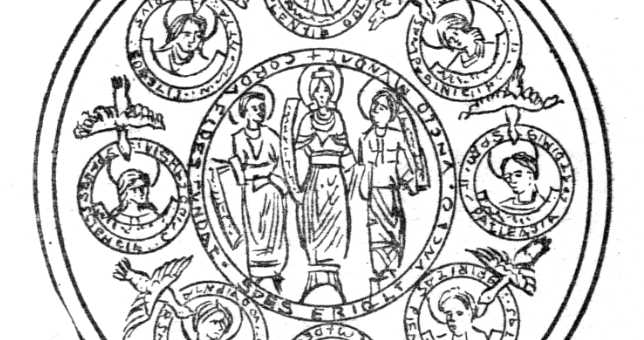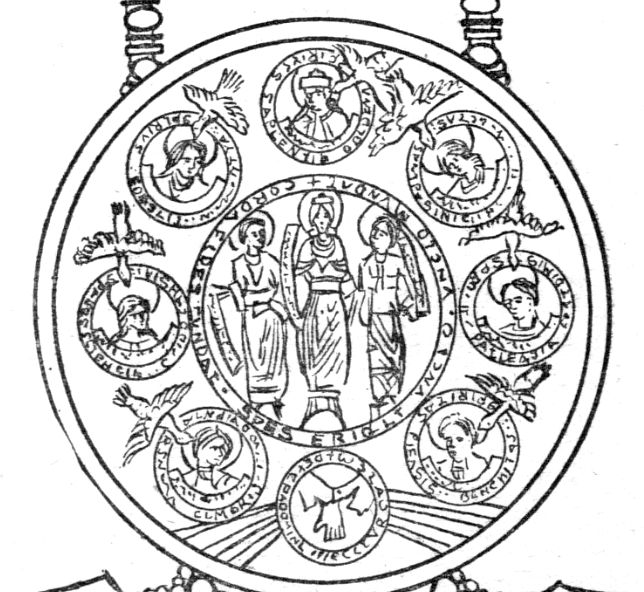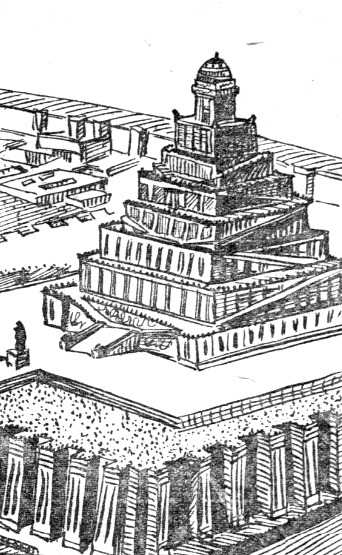
Why is the number seven supposed to be lucky? How is the number connected to religions across the world? The article below, originally published in 1902, tackles these questions.
The History and the Mystery of the Lucky Number 7
Introduction
Why is the figure seven considered lucky? What is the origin of the power it is supposed to exert? These two questions, while answerable after study and research, are mysteries to the great mass of individuals.
Notwithstanding this ignorance, the figure seven is and has always been considered a lucky number. The professional man and the man of trades are alike influenced by this superstition.
But can the universal faith in the efficacy of seven be called a superstition?
That is one of the questions which Dr. C.J. Fletcher endeavors to make clear in the following article.
Dr. Fletcher, while in England some time ago, became interested in the mystery surrounding the history of the figure seven and instituted a series of investigations upon the subject. In the British museum he found complete data and the pictures herewith produced.
By Dr. C.J. Fletcher
The figure seven was of deep sacred significance in the beginning of civilization in Akkad and in Egypt.

The ancient Babylonians believed in seven great gods, in seven celestial spirits, called ighigs, and seven spirits of the underworld, called Anunnaki. Bel Merodach combatted and conquered seven wicked storm demons, Hell has seven gates; magic formulae must be repeated seven times in order to be efficient, and the great epic of the formation of the world was written on seven tablets, corresponding to the seven days’ work of the creation accounts in Genesis.
The mound Birs Nimrud was the site of “The Temple of the Seven Spheres,” rebuilt by Nebuchadnezzar the Great, who has written of it as having been built ages before upon the ruins which he found the tower. The Chaldeans have left bas-reliefs of the seven Ighigs and of their seven great gods, which Dr. Carus has reproduced. Even this sacred temple had its seven stories.
The number seven is popular among all the nations of the world because of the number of the days of the week, which are the fourth part of the circuit of the moon round the earth. The moon is the natural calendar of man, and its phases offer the most convenient mode of calculating time and determining dates. Now, the sidereal month consists of 27 days, 7 hours, and 43 minutes, nearly; the synodical month – i. e. from new moon to new moon – is longer, being 29 days, 12 hours, and 44 minutes, nearly; which yields an average of twenty-eight days, and this condition gave rise to the institution of the week. The week is among many nations a religious institution. So it was in ancient Rome, and every day was presided over by a special deity.
The progress of the sun in the region of the fixed stars during the twelve months led to a division of the heavens into twelve houses or mansions, which constitute the zodiac; and this is the reason why the number twelve is either closely connected with seven or placed in contrast to it.

Further, I point to the Egyptian unit of of measurement, the cubit, each divided into seven palms, and as seven has been one of the most awkward numbers for purposes of measurement we must assume that this division is due to the reverence for this oddest of prime numbers.
The same is true of the rainbow, whose division into seven colors is not founded upon fact, but betrays only the popular preferences for a number deemed sacred.
It is a strange coincidence that the human head is furnished with seven apertures – two eyes, two ears, two nostrils, and one mouth, but it is obviously farfetched to think that this is the reason for the sacredness of the number seven.
Seven also appealed to historic man, and I quote Maj. Powell’s “Lessons in Folklore” in proof:
Every tribe believes itself to inhabit the center of the world; thus we have a zenith world, a mild world, and a nadir world. Then they speak of a world to the north, of a world to the south, of a world to the east, and of a world to the west, for men think of the world in terms of cardinal points. Chained to this mode of thinking by the terms of language, the three worlds are multiplied and seven worlds are known – the mid-world, the under world, the upper world, the north world, the south world, the east world, and the west world. All tribal peoples, savage and barbaric alike, believe in these seven worlds as departments or pavilions to the world of earth.
“Under these circumstances, we need not wonder that a great number of arbitrary enumerations fixed themselves upon the number seven. We have seven sages in Greece, seven argonauts, and seven wonders of the world. The Pleiades which happen to consist of seven stars of great intensity, are deemed a constellation of special significance and power.
“The ancient Babylonians associated seven of their great gods with the seven planets were held to be the sun, moon, Jupiter, Venus, Mars, Mercury, and Saturn.
“Happily for the number seven two new planets, Uranus and Neptune, were discovered in due time when, owing to a change of our astronomical science and its terminology, the sun and the moon ceased to be regarded as planets. The old belief, however, unfortunately falls to the ground because the earth must now be counted among the planets, which would raise their number of eight – without counting the planetoids, about 300 altogether.

“There were seven jewels of the law in Buddhism which united to make up the bright diadem of Nirvana. These were purity, calmness, comprehension, bliss, wisdom, perfection, and enlightenment. There were seven points in Buddhist ethics which constituted religious endeavor, and there were seven kinds of miraculous property, consisting of the sword, the snake skin, the palace, the garden, the robes, the bed and the shoes. They are endowed with magical qualities; the shoes, for instance, convey the wearer 100 miles without fatigue and across water without wetting, the snake skin cannot be wetted by water nor shaken in the wind, neither become warm in heat nor cold in freezing weather.
“As the Greeks speak of seven sages so do the East Indians of the seven rishis (inspired men of great sanctity), and Hindu folklore discovers them in the seven stars of the Great Bear. The Chinese, too, know of the seven wise men who spurned the temptations of the world and retired to the bamboo grove, where they led a life of undisturbed rest and happiness.
“The awe of the number seven could only be enhanced when the first notions of mathematics dawned on the thinkers of mankind and when geometricians discovered hat the relation of the radius to the circumference of the circle could be roughly expressed by the number seven – or, what is the same, that the relation of the diameter to the circumference is approximately expressed by the number three and a half.
“It appears that the Jews developed their notion of the sacredness of seven on the same lines as the Babylonians and the Persians. It is well known that a seven armed candlestick stood in the temple at Jerusalem, and we cannot doubt that its seven lights were representative of the seven divine messengers of Yahveh, who are the same as the seven rulers in the starry heavens of the more ancient religions of Mesopotamia.
“Ezekiel, the Hebrew prophet, speaks in his remarkable vision of six men, every one holding in his hand a slaughter weapon and of another man with a writer’s inkhorn by his side. Our Bible version speaks of him as ‘among the six’ as though he were one of them, but Hebrew scholars interpret the passage in the sense that the man in linen who has not a slaughter weapon but an inkhorn is to be added to the other six, and Gunkel recognizes in the vision a reminiscence of the seven great planetary gods of the Babylonians. In his excavations at Nippur, Hilprecht has discovered many traces of the exiled Jews, and Ezekiel is full of allusions to Babylonian thought and religion. The man with the inkhorn, clothed in linen after the fashion of Babylonian priests, is no other than Nebo, the god of learning and the tutelary deity of priestcraft, represented by the planet Mercury.
“Is it mere accident, or are we confronted with echoes of older traditions when we find the number seven regarded as sacred throughout all medieval Christianity? There are frequent pictorial representations of the seven gifts of the spirit. The names of these seven gifts are not always the same; they vary considerably in various illustrations and are not always specified, since their several names are either supposed to be known or taken to be indifferent. But there is a general agreement as to the number of them, being the same as the Buddhist jewels of the law.

“The Christian church adopted the doctrine of the seven celestial regions. St. Paul speaks of the seventh heaven. Further, there are the seven spirits, which are before the throne of Him which is and which was and which is to come, reminding us of the seven ighigs of the Chaldeans. Not only is the number seven frequently referred to as a sacred number by St. John the Divine in the Revelation as well as by the church fathers, but we have also the evidence of the Christian monuments.
“Christ is represented on a lamb found in the catacombs as the Good Shepherd who carried a lamb in the usual style, and is surrounded to represent the seven churches of the Revelation. About the Good Shepherd appear the figures of the sun and moon, and between them are the seven stars. On the right side of the Good Shepherd we see a small box representing the ark of Noah, with a dove standing upon it; the picture on the left side is meant to represent Jonah under the gourd vine.
“The Christian view of the seven heavens ruled by the seven planets remained unaltered until the Copernican world conception took its place and caused the old Christian pictures of the universe to be regarded as mere archaeological curiosities.
“The sevenfold nature of the spirit of the Savior is also indicated in the Revelation of St. John, where the lamb is represented with seven horns and seven eyes. In the same book we read: ‘Worthy is the lamb that was slain to receive power, riches, and wisdom, and strength, and honor, and glory, and blessing, which are seven qualities.’
“In the manuscript Bible of the twelfth century, now in the British museum, we find a picture of the seven gifts of the spirit, represented in female heads; the spirit of wisdom is placed at the top, and wears a crown on her head. Besides the name of the gift, each representative figure bears an appropriate sentence, and the circle of these seven little figures is completed by a hand representing the presence of God the Father sending out twelve rays of light corresponding to the twelve apostles. The figures of Faith, Hope, and Charity occupy the center of the circle, and Charity, being the greatest of the three, is distinguished by a crown. The other six gifts are understanding, the strength of patience, the bliss of piety, the wisdom of counsel, the knowledge of temperance and the power of the Lord.
“In the Bible seven is a number of great significance. In the first chapter of Genesis we read that God rested on the seventh day from his works, and he consecrated it as a Sabbath. ‘Whosoever slayeth Cain, vengeance shall be taken on him sevenfold.’ Noah was commanded by God, according to the priestly account of the deluge, to take seven pairs of all clean animals into the ark. Jacob served seven years for Leah and seven other years for Rachel. Jacob bowed before Esau seven times. Pharaoh saw in a dream seven well-favored and fat-fleshed kine. Joseph mourned for his father seven days. The Lord smote the river Nile for seven days. The children of Israel were commanded seven days to eat unleavened bread. The law demanded that a Hebrew slave should serve six years and in the seventh he should go out free for nothing. In the temple service the priest had to dip his finger in the blood of the sacrificed bullock and sprinkle of the blood seven times before the Lord, before the veil of the sanctuary. A woman after the birth of a male child was unclean seven days. The Lord threatens to punish the people for disobedience with all kinds of terrors, and if they will not yet for all this harken, then he will punish them seven times more for their sins. Balaam requested Balak to build seven altars and prepare seven oxen and seven rams. In Deuteronomy we read among the curses on disobedience that the children of Israel will flee before their enemies on seven ways, but if they harken unto the Lord their enemies shall flee on seven ways. The walls of Jericho fall on the seventh day before the blast of seven rams’ horns, blown by seven priests, after having compassed the city seven times. Bathsheba’s child died on the seventh day. Because David had numbered the people, the children of Israel were punished, and a choice was given him between seven years of famine, three months of flight and three months of pestilence. Naaman became clean of his leprosy by bathing seven times in Jordan. Job’s friends mourned with him seven days and seven nights. Seven days is the time of mourning for a dead person. The psalmist sings that seven times a day he does praise God. In Proverbs xxiv, 16, we read that a just man falleth seven times and riseth up again.
“The symbolism of numbers attributes to seven a peculiar sanctity. Being the sum of three and four, it means the All as ensouled by God. Three means the Deity; four, the world; and thus seven is the sum of the two and represents the entire cosmos, God, and the world.
“These are part of the data I was able to find regarding the history and import of the number seven.”
Source: The Saint Paul globe. (St. Paul, Minn.), 03 Aug. 1902.

